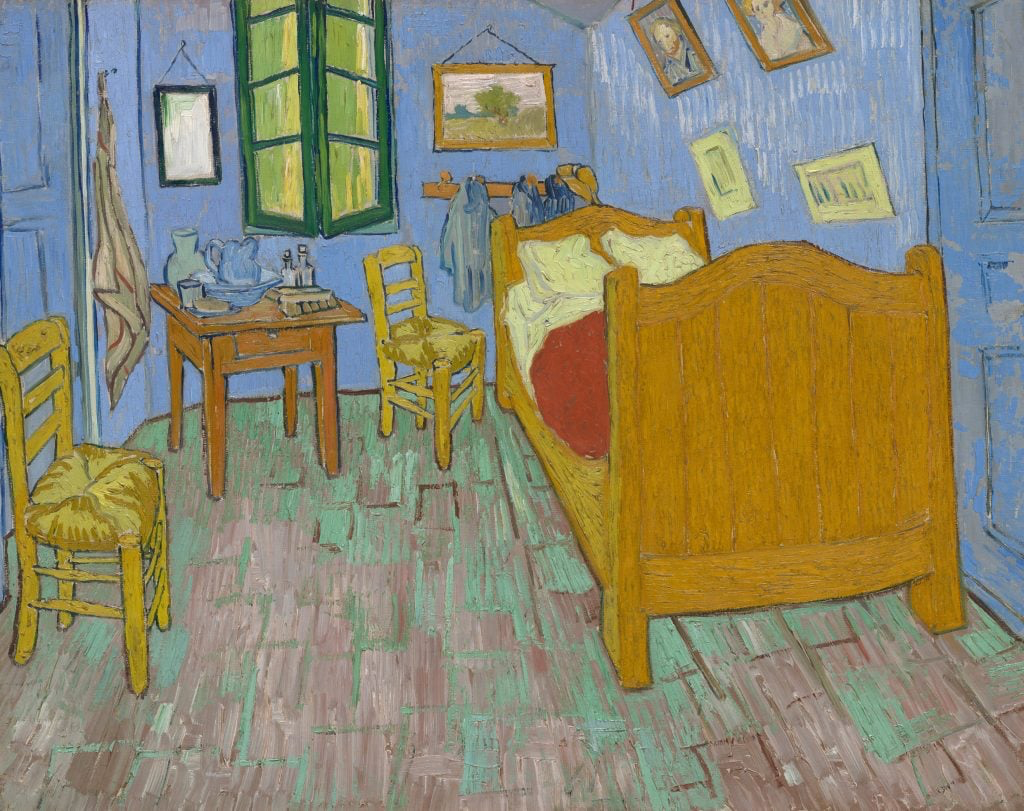Vincent van Gogh’s The Bedroom (1889) is one of the most iconic works in the history of art. Painted during his stay at the Yellow House in Arles, France, this piece represents far more than a simple depiction of a room; it is a deeply personal and emotional reflection of van Gogh’s inner world. Through vibrant color, expressive brushwork, and a deceptively simple composition, The Bedroom invites viewers into the intimate space where van Gogh dreamed, worked, and sought solace from his troubled life.
Historical Context
Van Gogh painted The Bedroom in October 1889 while recovering at the asylum in Saint-Rémy-de-Provence. This version, the third iteration of the painting, was created as a gift for his mother and sister. It replicates the original painting he created a year earlier while living in Arles. During his time in the Yellow House, van Gogh envisioned the bedroom as a place of rest and peace, yet his tumultuous mental state and strained relationships often clashed with this ideal.
The painting came during one of the most prolific yet emotionally taxing periods of van Gogh’s life. His time in Arles marked both a creative high point and the deterioration of his mental health, culminating in the infamous episode with Paul Gauguin and the mutilation of his ear. Despite these challenges, van Gogh’s work from this period radiates vitality and innovation.
Composition
The Bedroom is a relatively small, square-shaped painting that focuses on a straightforward interior scene. The composition is dominated by the bed positioned slightly off-center, flanked by two chairs and surrounded by walls adorned with simple decorations. The room appears somewhat compressed, with tilted planes and skewed perspectives, giving it a dreamlike quality.
The skewed perspective is one of the painting’s defining features. It distorts the viewer’s sense of space, creating an uneasy yet intimate feeling. This stylistic choice was likely deliberate, as van Gogh sought to convey not just the physical appearance of the room but also his emotional experience within it.
Color Palette
Van Gogh’s use of color in The Bedroom is both striking and symbolic. The dominant tones of yellow, green, and blue create a sense of warmth and simplicity. Each color serves a specific emotional purpose:
•Yellow: The bed and chairs are painted in warm, golden tones, symbolizing comfort and energy.
•Blue: The walls and doors are a calming yet slightly melancholic blue, evoking both peace and isolation.
•Green and Red Accents: These colors add vibrancy and tension, reflecting van Gogh’s restless inner state.
The color palette demonstrates van Gogh’s understanding of complementary colors and their emotional impact. The contrast between the warm yellows and the cool blues heightens the painting’s visual dynamism.
Brushwork
Van Gogh’s characteristic impasto technique—thick, textured brushstrokes—is evident throughout The Bedroom. The strokes follow the contours of the objects, adding movement and energy to the static scene. For example:
•The bedspread features fluid, undulating strokes that suggest softness and warmth.
•The wooden floorboards are rendered with long, horizontal strokes, guiding the viewer’s eye into the depth of the room.
This tactile quality makes the painting feel alive, as if the room itself breathes with van Gogh’s emotions.
Details and Symbolism
Every detail in The Bedroom contributes to its narrative and emotional resonance:
•The Bed: Central to the composition, the bed represents rest and refuge, though its slightly disheveled appearance hints at van Gogh’s restless nature.
•The Chairs: Positioned on either side of the room, the chairs symbolize absence and loneliness. Their placement creates a sense of imbalance.
•The Portraits and Decorations: The small paintings on the wall, believed to depict friends or family, emphasize van Gogh’s longing for connection.
•The Open Door: The partially ajar door invites the viewer into the room, blurring the boundary between public and private space.
Emotional Resonance
The Bedroom is often described as a self-portrait in disguise. While it does not depict van Gogh’s likeness, the painting captures his emotional state during a period of intense longing for stability and companionship. The simplicity of the room contrasts with the complex emotions it conveys: a mixture of comfort, vulnerability, and isolation.
Van Gogh himself wrote about the painting in letters to his brother Theo, explaining that he wanted the room to convey a sense of rest and tranquility. However, the distorted perspective and vibrant colors suggest underlying tension, as if peace was an elusive dream for the artist.
Connection to Van Gogh’s Life
The Yellow House was van Gogh’s attempt to create a haven for artists, a place where creativity and camaraderie could flourish. However, his dream was short-lived. His relationship with Gauguin deteriorated, and his mental health worsened. The Bedroom reflects this duality: it is both a sanctuary and a site of unresolved turmoil.
The repeated versions of The Bedroom—three in total—also speak to van Gogh’s obsessive need to revisit and perfect his work. Each version captures subtle changes in color and detail, revealing van Gogh’s evolving perspective on the room and his own emotional state.
Legacy and Influence
The Bedroom is one of van Gogh’s most celebrated works, and its influence on modern art is profound. Its bold use of color, expressive brushwork, and emotional depth resonate with audiences to this day. The painting has inspired countless reinterpretations and homages, cementing its place as a cornerstone of Post-Impressionism.
Van Gogh’s ability to find beauty and meaning in everyday scenes paved the way for future artists to explore the emotional potential of ordinary spaces. His emphasis on personal expression over realistic representation has influenced movements ranging from Expressionism to Abstract Art.
Impression
Vincent van Gogh’s The Bedroom (1889) is more than a depiction of a room—it is a window into the artist’s soul. Through its vibrant colors, dynamic brushwork, and symbolic details, the painting encapsulates van Gogh’s longing for peace and his struggle with inner turmoil. It invites viewers to step into his world, not just as observers but as participants in his emotional journey. Over a century later, The Bedroom remains a testament to van Gogh’s genius and his enduring ability to connect with the human experience.
No comments yet.








